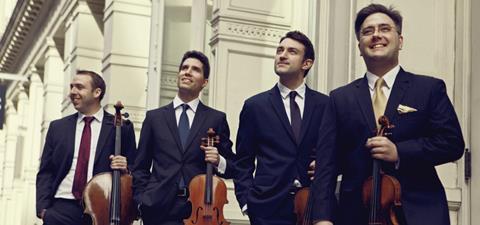Second violinist Aaron Boyd discusses a rehearsal of Mendelssohn’s String Quartet no.4

Discover more Featured Stories like this in The Strad Playing Hub.
This article was published in The Strad May 2016 issue
Sitting down for the Escher Quartet’s dress rehearsal of Mendelssohn’s op.44 no.2, I am mindful of mishaps from last night’s performance. They act as steadfast reminders of what we need to work on today. From the outset we face challenges of intonation and ensemble: the cello and second violin share uncompromising perfect intervals for most of the first phrase. The two of us practise these together before the first violin and viola join us again.
Next we look at the syncopated material that follows in the second violin and viola parts. We ask our cellist to stand back and listen, to make sure that we are balancing clarity of attack and release within the overall sound. Our syncopated impulses should neither overwhelm the soaring first violin melody, nor be too distant. We play through much of the first movement, taking special care that the semiquaver passages, passed from one instrument to another, fit together smoothly yet have a larger, unified shape and direction.
The second movement is a tour de force: a spectacular scherzo. My former chamber music teacher, the late cellist Harvey Shapiro, once told me how, as a member of the Primrose Quartet, he played this at a New York party held for Rachmaninoff. When they reached the end of this movement, the composer stopped the performance and asked them to repeat it!
Most nights I’m glad that Rachmaninoff isn’t in the audience to ask the same of us: I find that the lightness of this movement makes it diabolical to play in concert. The accents, grace notes (which benefit from a little left-hand pizzicato to get them to ‘pop’) and bursts of semiquavers all require clarity and perfect ensemble. They should never become aggressive – at least not until the climax at bar 111, when cello, viola and second violin trade off semiquavers, creating the illusion of one continuous line. Here, we let ourselves go, being careful to match our volume and projection.
It’s important to run the scherzo in its entirety. The flying staccato at the end of the movement can be disarmingly simple to play by oneself, considering how difficult it becomes in performance! This is especially true when our bowing arms are feeling fatigued from playing the demanding music that comes beforehand.
The third movement – a beautiful song without words – has been giving us difficulties all week. It is Mozartian in its subtlety, and Mendelssohn emphasised that it should ‘never be allowed to drag’. With too little nuance or rubato, it risks sounding like a sewing machine; with too much, it sounds kitsch. The second violin part has a semiquaver Alberti-style passage from the beginning, running under the first violin melody, and I do my best to play it beautifully. To me it has never felt right or sounded good. The simple experiment of writing a viola cue into my music helps, because it releases me from feeling any duty to lead.
The last movement returns to the turbulence and agitation of the first. We remain sensitive to harmony and colour in the recurring motifs, so that they never sound repetitive. Each should reflect its place in the long chain of phrases, to suggest a sense of inevitability and purpose.
Mendelssohn’s tempo indications can be inconsistent and frustrating. The second section of the exposition is marked ‘Animato’, whereas the corresponding spot in the recapitulation has no marking at all. Nor is there any indication of when to return to tempo primo after the animato. We let the material decide for us by applying an animato to the analogous spot in the recapitulation and experimenting with how and when we return to tempo primo in the development.
In matters of this kind, pedantry gets you nowhere. It’s more useful to remember the words of Italian composer, writer and pianist Ferruccio Busoni: ‘What the composer’s inspiration necessarily loses through notation, his interpreter should restore by his own.’
The Eschers’ two-volume recording of the Mendelssohn Quartets is available on BIS Records
Read: Session Report: Escher Quartet on Janáček and Haas
Read: The challenges of recording Pierre Jalbert’s music: Escher Quartet
Discover more Featured Stories like this in The Strad Playing Hub.
The number one source for playing and teaching books, guides, CDs, calendars and back issues of the magazine.
In The Best of Technique you’ll discover the top playing tips of the world’s leading string players and teachers. It’s packed full of exercises for students, plus examples from the standard repertoire to show you how to integrate the technique into your playing.
The Strad’s Masterclass series brings together the finest string players with some of the greatest string works ever written. Always one of our most popular sections, Masterclass has been an invaluable aid to aspiring soloists, chamber musicians and string teachers since the 1990s.
American collector David L. Fulton amassed one of the 20th century’s finest collections of stringed instruments. This year’s calendar pays tribute to some of these priceless treasures, including Yehudi Menuhin’s celebrated ‘Lord Wilton’ Guarneri, the Carlo Bergonzi once played by Fritz Kreisler, and four instruments by Antonio Stradivari.






































No comments yet